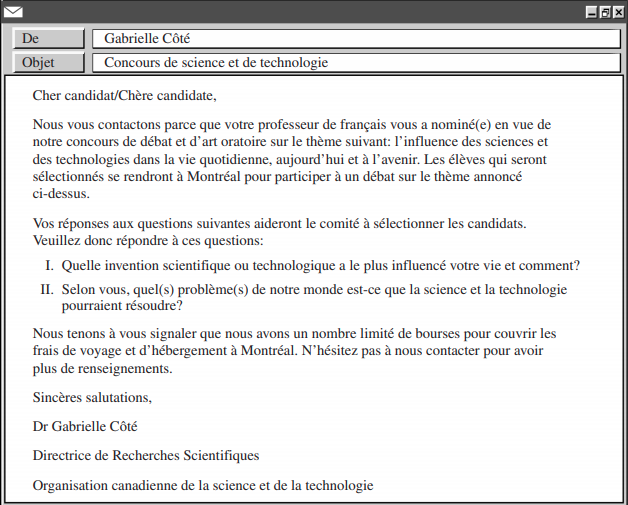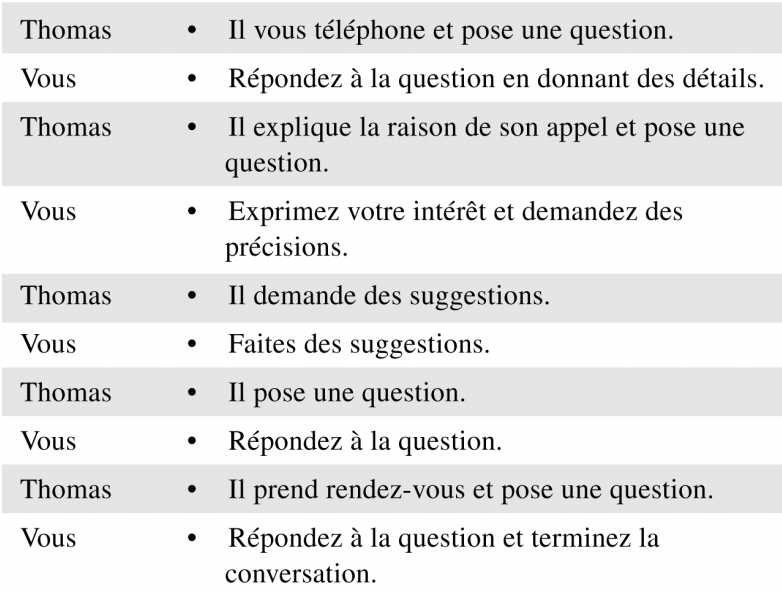AP French Exam Guide
11 min read•july 18, 2021
Haseung Jun
AP French 🇫🇷
52 resourcesSee Units
AP French Exam Guide
Exam Overview
The AP ® French Language and Culture exam will assess your understanding of French by testing your ability to apply “interpersonal, interpretive, and presentational modes of communication in real-life situations” (CollegeBoard®). So what does that mean? It means you’ll have to be able to speak, understand, read, and write in French. Surprise, right? Well, aside from needing your extraordinary French skills to succeed on the exam, it’s helpful to know what will be on it and how to prepare yourself. 🤩

Image from Pixabay
What’s on the Test?
There are six units for the AP French course:
Unit One: Families in Different Societies 👨👩👧👧
Unit Two: The Influence of Language and Culture on Identity 🎭
Unit Three: Influences of Beauty and Art 🎨
Unit Four: How Science and Technology Affect Our Lives 🧪
Unit Five: Factors That Impact the Quality of Life 📊
Unit Six: Environmental, Political, and Societal Challenges 🌷
The College Board decided to be friendly and also provided us with some skills to master! They are:
-Present in Writing - presentational communication by written presentations
-Comprehend Text - written, audio, audiovisual, and visual text (text, pictures, and numbers)
-Make Connections - interdisciplinary and cultural connections
-Interpret Text - the content of written or audio text (words)
-Make Meanings - make meanings from words and expressions
-Speak to Others - interpersonal communication by speaking with others
-Write to Others - interpersonal communication by writing to others
-Present Orally - presentational communication by spoken presentations
How is the Exam Formatted?
The AP French exam is roughly 3 hours long. There are 65 multiple-choice questions (MCQs) and 4 free-response questions (FRQs). The FRQs consist of an email reply, persuasive essay, simulated conversation, and cultural comparison.
| Type of question | Number of questions | Time | Percent of score |
| Multiple Choice | 30 | 40 minutes | 23% |
| Multiple Choice with Audio | 35 | 55 minutes | 27% |
| Writing (Interpersonal and Presentational) | 2—email reply and persuasive essay | 1 hour and 10 minutes—15 minutes for the email reply and 55 minutes for the persuasive essay | 25% |
| Speaking (Interpersonal and Presentational) | 2—simulated conversation and cultural comparison | 18 minutes—10 minutes for the simulated conversation and 8 minutes for the cultural comparison. | 25% |
| Totals | 69—65 MCQ and 4 FRQ | Approximately 3 hours | 100% |
Section I: MCQs
The first section of the exam is basically like the SAT in French! Exciting 🙄, right ? But don’t worry! Fiveable has gotcha 💪🏻 So, let’s dive into the multiple-choice section!
Stimulus Based MCQ Sets
There are 65 questions divided into 9 sets. Each set contains a stimulus and 5-11 questions following it.
MCQ Sets
-Promotional Materials (5 questions)
-Literary Text (7 questions)
-Article Chart (11 questions)
-Letter (7 questions)
-Audio Report and Article (10 questions)
-Conversation and Chart (7 questions)
-Interview (5 questions)
-Instructions (5 questions)
-Presentation (8 questions)
Part A (without audio)
For this section, you’ll just read 👀 a text (ex. journals, literary texts, announcements, advertisements, letters, charts, maps, tables) and answer questions based on your understanding. You got this!
Part B (with audio)
For this section, there will be 2 sets of audio and text (ex. article and interview) combo stimuli. Then you’ll need to listen👂 to 3 sets of just audio (ex. presentation) with questions after it. This is the “Interpretative Communication” skill that the College Board is assessing.
💡 TIP: Always know that you’ll be able to listen to all audio tracks TWICE! This means that even though you might miss something the first time the track plays, you’ll have a chance to catch it the second time!
Helpful Tips for MCQ
These five tips will help you get a five on your exam.
1. Always read the questions and answer choices before listening to the audio. This will help you know exactly what you should listen for before you even press play👂
2. Take notes during the audio and write down what you think the answer is to the questions you have (hopefully) previously read 🤔
3. Keep moving. If you are stuck with one question, move on to the other questions and come back later. Keep track of time ⌚so you know when to move on.
4. If you cannot possibly think of the correct answer, GUESS!
5. Take a deep breath and don’t panic! Staying calm always helps 😉
Section II: FRQs
Now, let’s discuss the four FRQs!
Written Tasks
Email Reply 📧
The first task is to read and reply to a professional email. You will have 15 minutes to complete the task, and during that time, you should:
-Respond to the email in a formal tone.
-Use proper greetings and closings (but must be different from the given email).
-Thank the sender for the “offer”.
-Answer all the questions.
-Ask for information by asking a question
Strive for Five Vocab
This is the vocabulary you need to know to be on your way to getting a 5 on the email reply.
Greetings:
-Cher Monsieur + title: Dear Sir
-Chère Madame + title: Dear Madame
-Monsieur, Madame: To whom it may concern
-Monsieur le Directeur: Dear Director, head of .... (male)
-Madame la Directrice: Head of ... (female)
-Monsieur le Maire: Mr. Mayor
Closings:
-Cordialement: Cordially / kind regards (formal)
-Sincèrement: Sincerely
-Je vous souhaite une bonne journée: I hope you have a nice day
-A bientôt: See you soon
-Je vous prie d'agréer mes salutations distinguées: Please accept my distinguished salutations (super formal)
-Sincères salutations/Mes sentiments respectueux: My regards
-Sentiments respectueux/Mes sincères salutations: Best wishes
-Sentiments distingués: Sincere wishes
-Je vous prie d'agréer/Je vous prie d'accepter - Please accept
-Je suis impatiente de...(voyager au Québec): I'm excited (to travel to Quebec).
-J'ai hâte de...(travailler avec vous): I'm excited (to work with you).
-En vous remerciant à l'avance: Thanking you in advance
Five Helpful Tips
Don’t be intimidated! After all, writing emails are just… writing emails! It’s not a super heavy task 😄 Just think of it as a person-to-person interaction on paper. Emails are usually a job or intern opportunity or advertisement and/or invitation, so don’t think of it as too hard. This task is typically the easiest for students. Make sure to:
1. Memorize the instructions (they’ll be the same for every exam) so you can spend as much time writing as possible ✏️
2. Know to whom you’re “replying”.
3. Use more advanced grammar 🤓 if you can (i.e. subjunctive).
4. Keep track of time ⏲️
5. Practice, practice, practice!! Practice makes perfect.
Sample Email Reply

2015 AP French Free Response Question. Image from College Board
Here is a real reply written by a student who received a score of 5!
Chere Madame,
J’ai bien reçu votre courriel et vous en remercie! Je suis enthousiaste de poser ma candidature à votre organisation pour participer dans ce concours! J’ai hâte de montrer ma capacité de parler couramment quant aux sciences et aux technologies!
Je vous serait reconnaissant de bien vouloir m’indiquer combien de jours ce débat dure à Montréal? De plus, serait-il possible pour ma famille de venir me voir, si je suis choisi par votre comité?
En ce qui concerne vos questions, je pense que le smartphone, le portable qui peut faire tous, est l’invention plus importante de nos jours, car des smartphones permettent des gens de partager des idées plus rapidement que d’ailleurs. En outre, des smartphones peuvent aider des scientifiques à parler et travailler ensemble quand ils mènent des expériences pour lutter contre les maladies, et donc ils peuvent ensemble créer des médicaments plus efficaces, s’ils soient plus connectés!
Merci pour l’occasion de participer dans ce concours! Dans l’attente de votre réponse, je vous prie de bien vouloir agréer, Madame, mes salutations distinguées,
Un étudiant de Français AP
(Sample response from 2015 AP French Free Response Question - Courtesy of College Board)
Persuasive Essay ✍️
For this task, you’ll have around 55 minutes to read, listen and write. You should spend 15 minutes reviewing material and 40 minutes writing. There’s an article, an audio source (played twice), and an infographic. Usually, the article and audio source take one side (pro or con) and the infographic is neutral. Usually.
However, there are some constants across all exams. For the essay, you should always:
-Write a roughly 5-paragraph essay. It should contain an introduction, 3 body paragraphs and a conclusion.
-Develop a good, strong thesis (agree or disagree with the statement).
-Show your understanding of the sources by citing all of them at least once.
-Defend your viewpoint.
-Write an excellent introduction and conclusion.
Strive for Five Vocab
To Contrast Two Ideas:
-au lieu de cela: instead of that
-cependant: however
-malgré tout: in spite of everything/all the same
-pourtant: yet
-sinon: otherwise
-toutefois: however
To Show Sequence:
-tout d'abord: first of all
-de plus: moreover
-en deuxième lieu: secondly
-j'ajouterai que: I would like to add that
-en conclusion: finally
To Discuss Convincing Points:
-bien sûr que: of course
-certainement: certainly
-en effet: indeed
-en fait: in fact
-naturellement: naturally
-sûrement: surely
To Demonstrate Your Position:
-à mon avis/selon moi: in my opinion
-je suis persuadé(e)/convaincu(e) que: I am convinced that
-je maintiens que: I maintain that
-il est certain que: it is certain that
-il est incontestable/indéniable que: it is incontestable that
-dorénavant: henceforth, from now on
-en dépit de: despite
FIVE Helpful Tips
If you made it this far, it means you’re invested in studying for the AP exam. Even though the persuasive essay seems a bit arduous, it essentially follows a formula.
While you write, keep in mind to:
1. Include an introduction and a conclusion, as well as your three body paragraphs that serve to show each point of your argument.
2. Practice hard grammar and sentence structure before using them in your essay - it might sound really awkward if you misuse an expression!
3. Make sure to cite EACH source. Even if you don’t understand it, including it in your in-text citation is crucial.
4. Stay consistent with your point of view! Don’t change it in the middle and make sure to disprove the opposing argument.
5. Write in neat handwriting (or at least try). Though there is no written rule, remember the poor judges who have to read thousands of these essays with the same topic - you don’t want to get on their bad side!
💡REMEMBER: You’ll have access to the article and the infographic all the time, but not the audio source! So, take detailed notes while it is played twice!
Spoken Tasks
Simulated Conversation 🗣
During the simulated conversation, you will speak 5 times for 20 seconds. Make sure to follow the given outline and (usually) the conversation should be informal.
In this task, you should:
-Speak!
-Follow the general outline.
-Fill up the whole 20 seconds.
-Use comprehensible grammar and vocab.
-Keep the “conversation” flowing.
Strive for Five Vocab
-Je suis d'accord: I agree
-C'est vrai: It is true
-C'est certain: It is certain
-Bien sûr: Of course
-Je veux bien: I am ok with that/ I don't mind
-Bien entendu: Got it
-Avec plaisir: With pleasure
-Pas de problème: No problem
-Je le crois: I believe it
-Je pense que oui: I think so
FIVE Helpful Tips
For this task, you will use your French speaking and listening abilities combined and simultaneously. Though it may be hard, continued practice will help you a ton! While speaking, keep in mind to:
1. Follow the outline given to you (there’s a reason why it’s given *wink wink*).
2. Stay calm if you don’t understand something. Keep calm and engage in the conversation. Have a little fun!
3. Avoid using “um”.
4. Fill up the 20 seconds (better to go over than under).
5. Practice with your teacher, friend, or by using past samples from the College Board website!
Sample Conversation Task
Introduction: C’est une conversation avec Thomas, un camarade de classe. Vous participez à cette conversation parce que Thomas sollicite votre aide pour l’organisation d’un événement.

2019 AP French Free Response Question, Image from College Board
Cultural Comparison 💬
Whew, last task! For this task, you’ll be given one minute to read the directions and four minutes to prepare for the presentation. But since you, as a smart student, have already memorized 🧠 the directions, you should essentially have five minutes to prepare. Then, you’ll have two minutes to speak 💬 While preparing and speaking, you should:
-Compare a francophone culture to your own culture.
-Elaborate on similarities and differences.
-Fully show your understanding of each culture with fantastic French grammar.
Strive for Five Vocab
-cependant: however
-neanmoins: nevertheless
-mais: but
-tandis que: while
-alors que: even though
-d’abord: first
-tout bien considere: all things considered
-cela va sans dire que: it goes without saying that
-je voudrais souligner que: I would like to underline that
-il faut que: it is necessary that
-puis/ensuite: then
-par exemple: for example
-de la même façon: in the same way
-pareillement: similarly
-identiquement: in exactly the same manner
-en revanche: on the other hand
-d’un côté ….. a l’autre côté: on the one hand … on the other hand
-a l’inverse: conversely
FIVE Helpful Tips
This is the last thing you’ll do during the AP French exam, so by the time you’re completing this task, you might be exhausted. But remember, it’s the last one, so make it your best! Don’t give in to exhaustion (leave that for after the exam) and finish strong! For this task, you should:
1. Compare and contrast BOTH cultures (don’t start on one and get stuck on it—it’s always better to talk about both cultures even if you don’t get to all of your points).
2. When in doubt, talk about your personal experiences with French culture. No one can count it as wrong if it’s personal!
3. Don’t rush through all your points. Two minutes will feel long or short depending on how much you prepare - remember: running over your time is better than running under!
4. Use your prep time to its greatest extent! Don’t waste a second.
5. Study and become aware of French culture before the exam - it’ll only help you 😀
Sample Cultural Comparison Task
Sujet de présentation : Quelle est l’importance de la manière de s’habiller pour les gens de votre communauté ? Comparez ce que vous avez constaté ou remarqué dans les communautés où vous avez vécu avec ce que vous savez d’une région du monde francophone. Dans votre exposé, vous pouvez faire référence à ce que vous avez étudié, vécu, observé, etc.
(Sample task from 2019 AP French Free Response Question - Courtesy of College Board)
Final Tips and Conclusion
Okay, so we’ve made it this far going through all the parts of the AP French exam. And was it mentioned in the guide that this exam is to test how well you’re good at French? Well, it is. And guess what? YOU ARE GREAT AT FRENCH! You know it and we all know it. So don’t be too scared of the exam and remember that you’ll ace it.
Some final (and overall) tips are to:
-Try to use French in your everyday life.
-Practice past AP French exam FRQs from the College Board. Make sure to grade them after you are done so you know how to improve.
-Know grammar and vocab (and idioms and expressions): noun genders, verb tenses, useful expressions will all help you (and make you sound cool!).
-Memorize the instructions BY HEART so on the exam day, you can start working immediately.
-Continue to expose yourself to francophone culture.
-Eat a healthy breakfast the day of your exam.
-Take a deep breath, keep calm…and CRUSH 🔥 that test.
Good luck to you all and remember: the exam is FIVEABLE!!
Browse Study Guides By Unit
👨👩👧Unit 1 – Families in French-Speaking Countries
🗣Unit 2 – Language & Culture in French-Speaking Countries
🎨Unit 3 – Beauty & Art in French-Speaking Countries
🔬Unit 4 – Science & Technology in French-Speaking Countries
🏠Unit 5: Factors That Impact the Quality of Life
🌪Unit 6 – Challenges in French-Speaking Countries
✍️Exam Skills - FRQ/MCQ

Fiveable
Resources
© 2023 Fiveable Inc. All rights reserved.